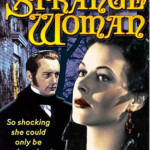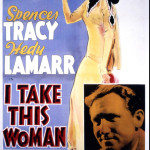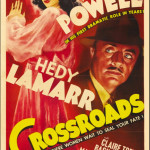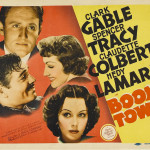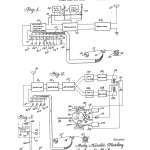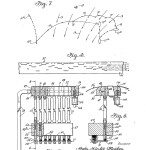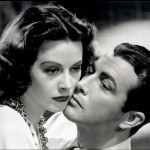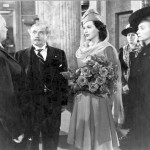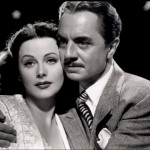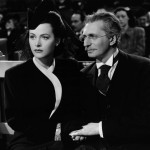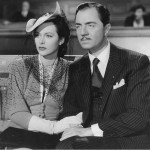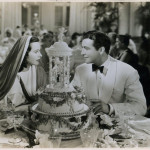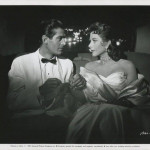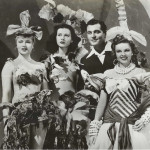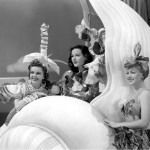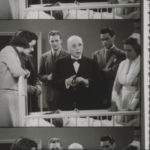When Next You Use Bluetooth, Think of Hedy Lamarr
An industry group wants to find women who are emulating the film star Hedy Lamarr who, while most remembered for her film roles, more importantly devised a method of scrambling radio signals and ushered in a range of modern-day communications devices.
n
By Peter Monaghan
n
You may not know any women in the entertainment industry who have excelled in technological innovation, but perhaps you know a young woman at a college or university who shows great promise of doing so.
In either case, the organizers of the first Hedy Lamarr awards want to hear from you.
DEG: The Digital Entertainment Group, an association of large American and global entertainment and information-technology companies, is taking nominations until 1 March 2017 for two new, annual awards. The Hedy Lamarr Award for Innovation in Entertainment Technology will recognize female executives who have made major contributions to technology in entertainment. The Hedy Lamarr Achievement Award for Emerging Leaders in Entertainment Technology will support a female college student in her junior year.
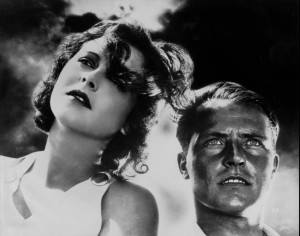
A teenaged Hedwig Eva Kiesler, who would become Hedy Lamarr, with Aribert Mog in her notorious 1933 appearance in the relatively artful and certainly now-anodyne “Ecstasy,” perhaps the first film in which fields of swaying wheat served as a metaphor for sexual bliss.
Before you nominate anyone, you may well ask: What has Hedy Lamarr, a Hollywood movie star from the late 1930s through the 1950s, got to do with advances in entertainment technology, or any other kind?
Quite a bit. And that’s a side of Lamarr’s life and career that has been attracting attention, of late.
The DEG has set up the awards, which will be made in November 2017 to coincide with the 103rd anniversary of the Austrian-American star’s birth, because while she had star turns in such hits as Samson and Delilah, The Strange Woman, and Tortilla Flat, not to mention an infamously dishabille role in the early Czech feature, Ekstase (Ecstasy, 1933), she also registered an important patent in 1942. It was for a method of secure radio communications that was intended to aide the Allies war effort, and paved the way for such technologies as wi-fi, bluetooth, GPS technology, and cell phones.
That’s surely one of Hollywood’s more improbable biographies.
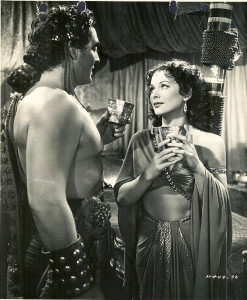
Delilah (Lamarr) bats at Samson (Victor Mature) in “Samson and Delilah,” 1949. He shouldn’ought’ve snubbed her.
Several recent books have presented aspects of Lamarr’s life and career. Most notable have been Hedy Lamarr: The Most Beautiful Woman in Film by Ruth Barton, which the University Press of Kentucky published in its Screen Classics series in 2010, and Hedy’s Folly: The Life and Breakthrough Inventions of Hedy Lamarr, the Most Beautiful Woman in the World, by Richard Rhodes, which Doubleday issued the following year. In fact, the movie icon, who appeared in 35 features before her fortunes faded in her final years and even decades, has generated a small publishing industry. Books about her have ranged from the authoritative to the inanely salacious.
To start with the latter, because it has bizarrely influenced Lamarr’s reputation, there’s a sort-of-biography from 2008, What Almost Happened to Hedy Lamarr: 1940-1967, by Devra Z. Hill with contributions by one Jody “Babydol” Gibson. The protagonist of What Almost Happened is, as Ruth Barton puts it in her rather more dependable biography, a fictionalized “Hollywood actress named Hedy Lamarr…whose career is apparently best summarized by detailed accounts of her sexual romps and power-hungry manipulations.” Those include, in Devra Hill’s account, that Lamarr manipulates a movie mogul who resembles MGM mogul Louis B. Mayer, who in real life signed Lamarr to his studio. In the Hill “biography,” “Lamarr” has the goods on Belden (“Mayer”): photographs she took of him as he throttled an aspiring actor whilst she administered a sexual procedure upon his person.

Hollywood hype sustained the sobriquet that European theater director Max Reinhardt had conferred on the green eyed, purring-voiced Hedwig Eva Kiesler.
Barton has scant respect for Hill’s efforts: “That the book was written as a soft-porn narrative ought to be no surprise given Jody Babydol Gibson’s notoriety as the Hollywood brothel keeper whose tell-all publication, Secrets of a Hollywood Super Madam, named a string of high-profile celebrities as clients to her lucrative global escort agency.” (The book appeared under Gibson’s vanity imprint, Corona Books.)
Barton is more disdainful towards Hill. Her résumé, Barton notes, “includes masters’ and doctoral degrees from unaccredited universities and a career as a self-help nutritionist.” [The “universities” in question were Donsbach University and Golden State University.] Barton reports that Hill “claims that the star asked her to write her biography,” but “after Hedy’s arrest for shoplifting, Hill developed scruples and decided not to continue.” [Lamarr was twice charged with shoplifting, first in Los Angeles in 1966, eight years after her last film appearance and shortly after her sixth and final divorce – from Lewis J. Boies, her lawyer for some of the previous ones; the second arrest came in 1991, in Florida, when Lamarr was charged with stealing laxatives and eye drops. Her glamor days, which included romantic attachments to Howard Hughes and other high-profile figures, were then well behind her.]
Barton is most scathing about Hill’s claiming to reveal that Lamarr had — as one of innumerable newspaper reports dutifully interpreted some particularly dodgy publicity material — “once enjoyed sexual trysts with Nazi leader Adolf Hitler.”
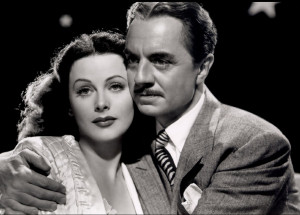
Lamarr, in a characteristic role, played a dud astronomer beautiful wife who dreams of a new fella in her life, played by William Powell, in “The Heavenly Body” (1944).
The press material, still displayed by Hill and Gibson, claims [typos and grammatical errors, sic] that “only Devra Hill got close enough to know [Lamarr’s] intimate secrets revealed to her through many shared moments of conversation they had together. Devra says ‘A cunning and brilliantly manipulative woman as exemplified in my chapter involving Hedy’s tryst with Adolph [sic] Hitler. Although initially taken by him against her will, Hedy remained in his good graces long enough to receive a diamond encrusted cigarette case as a gift from one of the most hated men of the twentieth century. Only Hedy could soothe the savage beast”.
Bizarrely, Barton observes, Hill’s book “has sold itself on its suggestion that Hedy was Hitler’s mistress, although in fact Hitler is never mentioned in the book and the suggestion is particularly obnoxious” [emphasis added].
When it came to bad press, Hedy Lamarr hardly helped herself with the publication in 1966 of her own Ecstasy and Me. She tried to renounce it, while suing the ghostwriters. The “disputed autobiography,” Barton says, “has become the official narrative of her life and career, heavily laced with spicy details of lesbian affairs, lovers (both named and unnamed), and the maneuvering of Hollywood’s power brokers, most notably Louis B. Mayer. It concludes with transcripts of her sessions with a psychoanalyst. Later, Hedy pronounced that none of this was true.”
Further complicating matters, Barton notes, is that “if much of Ecstasy and Me is fatuous 1960s pseudo-analysis, equally, much of it is…factual.”

An image from “Ecstasy” graced the cover of Thomas Laqueur’s “Solitary Sex: A Cultural History of Masturbation,” Zone Books, 2004. In the film, director Gustav Machatý evoked the yearning of an unsatisfied young wife through a sequence in which her swimming naked is interrupted by her horse’s running off to bill and coo with another, leaving the young woman to be discovered naked by her soon-to-be suitor.
Lamarr’s whole life was a mixed bag. She was born in 1914 and raised in Austria as Hedwig Eva Kiesler, the daughter of Jewish parents: a banker from Budapest and mother from Lviv. She studied ballet and classical piano, and attended an exclusive girls’ boarding school in Switzerland. Her first film role came in 1930; beginning the next year, she worked in three features with Peter Lorre. In 1932, when she was 18, she was filmed naked in Gustav Machatý’s Ekstase (Ecstasy) and when the film appeared in 1933 was suddenly famous, or at least infamous. Scenes of her running and swimming naked got the film banned in the United States – that, and a sequence of simulated adulterous sex that included close-ups of her face substantiating the film’s title. The film also made the Nazi-supporting arms merchant she married in 1933, Fritz Mandl, so jealous that he virtually imprisoned her in his castle home, Schloss Schwarzenau, later a setting for The Sound of Music. Mandl attempted to buy up all the prints of Ecstasy, to no avail. Lamarr told the Associated Press in 1997: “I was a kind of slave. When we were in Italy, I couldn’t even go swimming without him being there.”
Mandl held many dinner parties for prominent fascists and arms makers, builders, and buyers. Lamarr (then still Hedwig Kiesler) had already learned the workings of various machinery from her banker father, so was alert to Mandl and his collaborators’ discussions of weapons systems. That was the germ of her key later invention.
First, she needed to flee Mandl. In Ecstasy and Me, she — or her ghostwriters — wrote that she disguised herself as her maid and fled to Paris; but by other accounts, she persuaded Mandl to let her wear all of her jewelry for a dinner party, then disappeared with it. In Hedy’s Folly, Richard Rhodes suggests that Lamarr forced her secretly Jewish husband to free her by threatening to expose him to Austrian authorities for discussing state military secrets.
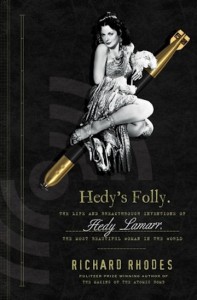 One way or another, Lamarr got clear of him, and worked for a short time on London stages before settling in Hollywood, where she went to work for Louis B. Mayer at MGM. She had met him on an ocean liner returning him to the U.S. He insisted she change her name to one that honored silent film star Barbara La Marr. And he was adamant that she make films that would erase her louche European reputation.
One way or another, Lamarr got clear of him, and worked for a short time on London stages before settling in Hollywood, where she went to work for Louis B. Mayer at MGM. She had met him on an ocean liner returning him to the U.S. He insisted she change her name to one that honored silent film star Barbara La Marr. And he was adamant that she make films that would erase her louche European reputation.
Lamarr became a wealthy star from her films of the war years and beyond, including Tortilla Flat, Lady of the Tropics, and Boom Town. But her roles were often limited, however loudly billed. She was outlandishly publicized as, for example, “the most beautiful woman in the world” (a title conferred on her back in Austria by the prominent theater director Max Reinhardt) and her green eyes and purring voice abetted the hype, even if her acting skills were modest. In 1942, after a series of roles won her some prominence, she made a bad miscalculation by turning down the lead in Casablanca.
Roles kept coming throughout the 1940s and into the 1950s, including the female lead opposite Victor Mature in Cecil B. DeMille‘s gradiose Samson and Delilah (1949), which broke Paramount Picture records for most profitable movie, hauling in $12-millon from theater rentals.
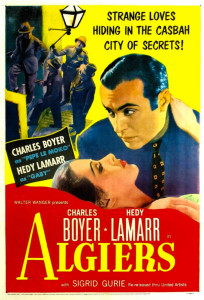 The story goes, however, that Lamarr found Hollywood life tedious, in part due to its personalities, and in part due to the intermittent nature of movie filming, and that in response she installed a drafting table in her house and set about working on designs. She came up with many: a fluorescent dog collar, a novel kind of traffic stoplight, an accordion-inspired method of tautening skin, a device for helping the infirm in and out of a bath, a bouillon-like cube for making a carbonated drink…
The story goes, however, that Lamarr found Hollywood life tedious, in part due to its personalities, and in part due to the intermittent nature of movie filming, and that in response she installed a drafting table in her house and set about working on designs. She came up with many: a fluorescent dog collar, a novel kind of traffic stoplight, an accordion-inspired method of tautening skin, a device for helping the infirm in and out of a bath, a bouillon-like cube for making a carbonated drink…
One of her ideas drew on knowledge she’d gained at those Nazi-courting parties of her first husband. She had also sat with him while he watched films of field tests of torpedo systems.
Long before her adopted United States entered World War II, Lamarr feared the conflict’s outcome. Determined to assist Allies campaigns, she focused on developing a means of defending ships against German submarine attacks. She settled on looking for a method of guiding torpedos with radio signals, which she knew would require protecting the signals from being jammed. Her breakthrough was coming up with a design for making radio signals jump from one frequency to another, thus evading interference. Rhodes believes she must have heard her husband and his cronies discussing radio jamming technologies being developed in Germany.
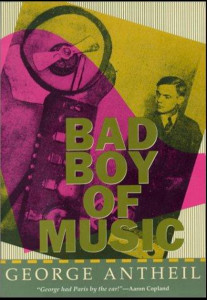 In 1940, at a dinner party thrown by actress Janet Gaynor, she met the composer George Antheil. She had asked Gaynor to introduce them, for a reason as unlikely as the collaboration that would stem from it: She wanted to ask Antheil about the endocrinological dimensions of her bust.
In 1940, at a dinner party thrown by actress Janet Gaynor, she met the composer George Antheil. She had asked Gaynor to introduce them, for a reason as unlikely as the collaboration that would stem from it: She wanted to ask Antheil about the endocrinological dimensions of her bust.
Say what?
Antheil, an American avant-garde composer, had been an habitué of Left Bank intellectual circles in Paris while living above Sylvia Beach’s legendary Shakespeare & Co. Bookstore. Imagine an afternoon tea at his apartment attended by Ernest Hemingway, James Joyce, T.S. Eliot, Ford Madox Ford, Ezra Pound, and Wyndham Lewis, and you’ll get the idea.
When Hitler’s rise threatened Europe, Antheil had returned to the United States. At first, as Richard Rhodes relates in Hedy’s Folly, Antheil lived in New York and wrote for Esquire magazine about one of his fascinations, the endocrine system: the way glands secrete hormones into the blood. He even published the book Every Man His Own Detective: A Study of Glandular Criminology.
In 1936, he and his wife drove across the country to Hollywood, and Antheil began scoring films for Cecil B. DeMille and others. His Hollywood compositions were far less daring than his earlier works, one of which, his 1924 Ballet Mécanique, was for 16 synchronized player pianos. In Hollywood, his relative conservatism permitted him to find moderate success, helped by a gift for self-promotion. Among films he scored was Stanley Kramer’s The Pride and the Passion (1957), which starred Cary Grant, Sophia Loren, and Frank Sinatra in a tale of Spaniards trying to win their country back from Napoleon.
{Click on an image to expand}
Lamarr had come to Hollywood, by that time, and she was quite taken with Antheil. They had in common a scandalous reputation. He was the “bad boy of music,” a renown he would cultivate in his 1946 autobiography of that title. He fancied himself an authority on many subjects, including endocrinology, and after reading an article he wrote about that field in Esquire magazine, she had Gaynor organize that dinner party.
Antheil helped her to devise a method based on using piano rolls and the 88 keys of a player piano to randomly switch radio signals among 88 channels. That approach, the basis of what became known as spread spectrum communication, paved the way for many forms of digital, wireless communications of later years. When next you use your cell phone, think of Hedy Lamarr.
{Click on an image to expand}
At first, however, the system went nowhere – at least, nowhere but onto a shelf at the US Navy, to which Lamarr and Antheil had given, for free, their 1942 patent, Secret Communication System. In their mechanism, if ever it was built, the rolling sheet would shift electronic switches rather than activated the piano’s 88 keys, and both radio transmitter and on-board receiver would simultaneously run the same coded paper sheet. Lamarr was only 27, at the time, and the New York Times, to which MGM leaked word of her off-lot efforts, was so impressed that it wrote: “So vital is her discovery to national defense that government officials will not allow publication of its details.”
The Navy considered the piano-roll-inspired mechanism too clumsy. Military officials thought Lamarr could best serve the war effort into allowing her image to be used to sell war bonds.
So the patent went nowhere until the 1950s, after it expired, when it was adapted by developers of a system called Code Division Multiple Access, a form of spread spectrum technology that does not use frequency hopping. When design improvements led to smaller, faster computer chips, versions of the Lamarr-Antheil concept came to be used in communications electronics, but also retained military applications, including in the American military’s Milstar defense communications satellite system, and in securing military communications on U.S. ships that blockaded Castro’s Cuba during the 1962 “missile crisis.”
In 1997, three years before Lamarr died at the age of 85, the Electronic Frontier Foundation awarded her and Antheil, who had died in 1959, its Pioneer Award. That was in large part due to the efforts of a previous recipient, Dave Hughes, who developed a wireless Internet design using the Lamarr-Antheil spread-spectrum approach. He told the Associated Press: “I was a 15-year-old fussing around with a crystal radio set just trying to get a signal in 1941, and here she was, intellectually articulating a control mechanism for torpedo guidance systems.”
{Click on an image to expand}
EFF official Mike Godwin pointed to spread-spectrum broadcasting’s contribution to access to the airwaves “for ordinary people with ordinary resources, such as Hughes had developed. He said the advent of inexpensive computers had made possible the mathematical firepower needed, but until then impracticable.
Of Lamarr and Antheil’s system, he said: “This tool they developed to defend democracy half a century ago promises to extend democracy in the 21st century.”
Unfortunately, he added, among the general public, there was “nearly absolute ignorance about it.”
That has changed, a little. Lamarr’s birthday, November 9, is now unofficially Inventors’ Day in Austria, Germany, and Switzerland. On 9 November 2015, the 101st anniversary of Lamarr’s birth, Google honored her with a “Google Doodle.”
The ultimate justice, for her, would be that she becomes as well known for her ingenuity as for her indifferent acting. The two new awards offered by DEG: The Digital Entertainment Group, to be judged by a panel of figures from entertainment, technology, higher education, information technology, and consumer electronics, promise to advance that cause.
Previous Post: A Resounding 25 Years of Reviving Early Film
Next Post: Grants to Preserve Films by Women and about US-Cuba Relations


